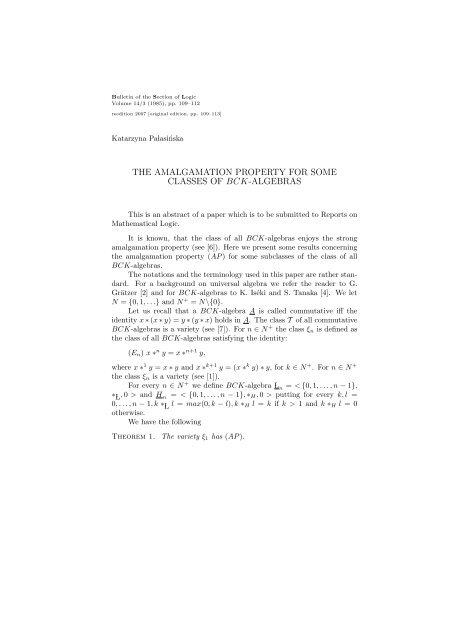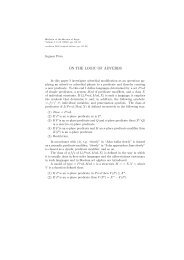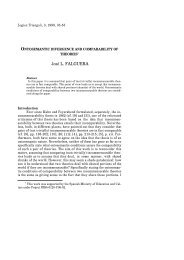the amalgamation property for some classes of bck-algebras
the amalgamation property for some classes of bck-algebras
the amalgamation property for some classes of bck-algebras
You also want an ePaper? Increase the reach of your titles
YUMPU automatically turns print PDFs into web optimized ePapers that Google loves.
Bulletin <strong>of</strong> <strong>the</strong> Section <strong>of</strong> Logic<br />
Volume 14/3 (1985), pp. 109–112<br />
reedition 2007 [original edition, pp. 109–113]<br />
Katarzyna Pa̷lasińska<br />
THE AMALGAMATION PROPERTY FOR SOME<br />
CLASSES OF BCK-ALGEBRAS<br />
This is an abstract <strong>of</strong> a paper which is to be submitted to Reports on<br />
Ma<strong>the</strong>matical Logic.<br />
It is known, that <strong>the</strong> class <strong>of</strong> all BCK-<strong>algebras</strong> enjoys <strong>the</strong> strong<br />
<strong>amalgamation</strong> <strong>property</strong> (see [6]). Here we present <strong>some</strong> results concerning<br />
<strong>the</strong> <strong>amalgamation</strong> <strong>property</strong> (AP ) <strong>for</strong> <strong>some</strong> sub<strong>classes</strong> <strong>of</strong> <strong>the</strong> class <strong>of</strong> all<br />
BCK-<strong>algebras</strong>.<br />
The notations and <strong>the</strong> terminology used in this paper are ra<strong>the</strong>r standard.<br />
For a background on universal algebra we refer <strong>the</strong> reader to G.<br />
Grätzer [2] and <strong>for</strong> BCK-<strong>algebras</strong> to K. Iséki and S. Tanaka [4]. We let<br />
N = {0, 1, . . .} and N + = N\{0}.<br />
Let us recall that a BCK-algebra A is called commutative iff <strong>the</strong><br />
identity x ∗ (x ∗ y) = y ∗ (y ∗ x) holds in A. The class T <strong>of</strong> all commutative<br />
BCK-<strong>algebras</strong> is a variety (see [7]). For n ∈ N + <strong>the</strong> class ξn is defined as<br />
<strong>the</strong> class <strong>of</strong> all BCK-<strong>algebras</strong> satisfying <strong>the</strong> identity:<br />
(En) x ∗ n y = x ∗ n+1 y,<br />
where x ∗ 1 y = x ∗ y and x ∗ k+1 y = (x ∗ k y) ∗ y, <strong>for</strong> k ∈ N + . For n ∈ N +<br />
<strong>the</strong> class ξn is a variety (see [1]).<br />
For every n ∈ N + we define BCK-algebra ̷L n = < {0, 1, . . . , n − 1},<br />
∗ ̷L , 0 > and H n = < {0, 1, . . . , n − 1}, ∗H, 0 > putting <strong>for</strong> every k, l =<br />
0, . . . , n − 1, k ∗ ̷L l = max(0, k − l), k ∗H l = k if k > 1 and k ∗H l = 0<br />
o<strong>the</strong>rwise.<br />
We have <strong>the</strong> following<br />
Theorem 1. The variety ξ1 has (AP ).
110 Katarzyna Pa̷lasińska<br />
This <strong>the</strong>orem can be proved by using <strong>some</strong> modification <strong>of</strong> Wroński’s<br />
method in [6]. It is worth to mention that <strong>the</strong> variety” ξ1 ∩ T which<br />
is determined by <strong>the</strong> 2-element BCK-chain ̷L 2 has (AP ) by virtue <strong>of</strong> a<br />
<strong>the</strong>orem <strong>of</strong> Grätzer, Lakser [3] stating that <strong>of</strong> a variety V has <strong>the</strong> congruence<br />
extension <strong>property</strong> and sub<strong>algebras</strong> <strong>of</strong> subdirectly irreducible <strong>algebras</strong> from<br />
V are subdirectly irreducible <strong>the</strong>n V has (AP ) iff every amalgam in <strong>the</strong> class<br />
<strong>of</strong> subdirectly irreducible <strong>algebras</strong> from V can be amalgamated in V.<br />
The next two <strong>the</strong>orems give necessary conditions <strong>for</strong> <strong>the</strong> class K <strong>of</strong><br />
BCK-<strong>algebras</strong> to have (AP ).<br />
Theorem 2. If <strong>for</strong> <strong>some</strong> n ∈ N + , K ⊆ ξn, K is closed wit respect to <strong>the</strong><br />
operation <strong>of</strong> <strong>for</strong>ming sub<strong>algebras</strong> and ̷L 3 ∈ K <strong>the</strong>n K does not have (AP ).<br />
Theorem 3. If K is closed with respect to <strong>the</strong> operations <strong>of</strong> <strong>for</strong>ming<br />
sub<strong>algebras</strong> and isomorphic copies, H 3 ∈ K and K has (AP ), <strong>the</strong>n <strong>for</strong><br />
every n ∈ N + H n ∈ K.<br />
get<br />
Since ̷L 3 ∈ ξn ∩ T <strong>for</strong> n ∈ N + , n > 1, <strong>the</strong>n by Theorems 1 and 2 we<br />
Corollary 1. For any n ∈ N + , ξn has (AP ) iff n = 1.<br />
Corollary 2. For any n ∈ N + , ξn ∩ T has (AP ) iff n = 1.<br />
Ano<strong>the</strong>r important consequence <strong>of</strong> Theorems 2 and 3 is <strong>the</strong> following<br />
full characterization <strong>of</strong> those varieties generated by finite BCK-<strong>algebras</strong><br />
which have (AP ).<br />
Theorem 4. For every variety V generated by a finite BCK-algebra, V<br />
has (AP ) iff V is trivial or V = HSP (̷L 2).<br />
To prove Theorem 4 let us note that <strong>the</strong> trivial variety <strong>of</strong> BCK<strong>algebras</strong><br />
as well as HSP (L 2 ) = ξ1 ∩ T have (AP ). To prove <strong>the</strong> converse<br />
implication we need <strong>the</strong> following:<br />
Lemma 1. For any variety V <strong>of</strong> BCK-<strong>algebras</strong> generated by its finite<br />
members, if V ⊆ HSP (̷L 2 ) <strong>the</strong>n {H 3 , ̷L 3 } ∩ V = ∅.<br />
Lemma 2. Every finite BCK-<strong>algebras</strong> satisfies an identity (En) <strong>for</strong> <strong>some</strong><br />
n ∈ N + .
The Amalgamation Property <strong>for</strong> Some Classes Of BCK-Algebras 111<br />
Now, if V = HSP (A), where A is a finite BCK-algebra and ̷L 3 ∈ V<br />
<strong>the</strong>n Theorem 4 follows from Theorem 2. The case H 3 ∈ V needs <strong>some</strong><br />
more attention.<br />
Following S. Nagata [5] <strong>for</strong> n ∈ N we define terms αn putting<br />
α0 = x0<br />
αn+1 = xn+1 ∗ [xn+1 ∗ (αn ∗ xn)]<br />
and we have<br />
Lemma 3. Every finite BCK-algebra satisfies an identity αn = 0 <strong>for</strong> <strong>some</strong><br />
n ∈ N.<br />
Lemma 4. For m, n ∈ N, if m > n + 1 <strong>the</strong>n αm = 0 fails to hold in H m .<br />
Returning to <strong>the</strong> pro<strong>of</strong> <strong>of</strong> Theorem 4 assume that V = HSP (A) where<br />
A is a finite BCK-algebra and H 3 ∈ V. Let us suppose that V has (AP ).<br />
Then by virtue <strong>of</strong> Theorem 3 H n ∈ V <strong>for</strong> every n ∈ N + . On <strong>the</strong> o<strong>the</strong>r<br />
hand <strong>for</strong> <strong>some</strong> n ∈ N, αn = 0 is an identity <strong>of</strong> V and – as αn = 0 is not<br />
satisfied in Hn+2 − Hn+2 ∈ V, a contradiction. Thus if H 3 ∈ V, <strong>the</strong>n V<br />
does not have (AP ).<br />
References<br />
[1] W. H. Cornish, Varieties generated by finite BCK-<strong>algebras</strong>, Bulletin<br />
Australian Ma<strong>the</strong>matical Society 22 (1980), pp. 411–430.<br />
[2] G. Grätzer, Universal Algebra, Springer-Verlag, New York<br />
(1979), 2nd edition.<br />
[3] G. Grätzer and H. Lakser, The structure <strong>of</strong> pseudo complemented<br />
distributive lattices, II, Congruence extension and <strong>amalgamation</strong>, Transactions<br />
<strong>of</strong> <strong>the</strong> American Ma<strong>the</strong>matical Society 156 (1971), pp. 343–<br />
358.<br />
[4] K. Iséki, S. Tanaka, An introduction to <strong>the</strong> <strong>the</strong>ory <strong>of</strong> BCK<strong>algebras</strong>,<br />
Ma<strong>the</strong>matica Japonica 23 (1978), pp. 1–26.<br />
[5] S. Nagata, A series <strong>of</strong> succesive modification <strong>of</strong> Pierce’s rule,<br />
Proceedings Japan Academy 42 (1966), pp. 859–861.<br />
[6] A. Wroński, Interpretation and <strong>amalgamation</strong> properties <strong>of</strong> BCK<strong>algebras</strong>,<br />
Ma<strong>the</strong>matica Japonica 29 (1984), pp. 115-121.
112 Katarzyna Pa̷lasińska<br />
[7] H. Yutani, The class <strong>of</strong> commutative BCK-<strong>algebras</strong> is equationally<br />
definable, Ma<strong>the</strong>matics Seminar Notes 5 (1977), pp. 207-210.<br />
Department <strong>of</strong> Logic<br />
Jagiellonian University<br />
Cracow, Poland






